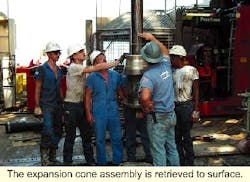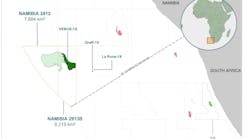DRILLING TECHNOLOGY: Casing expansion, test process fine tuned on ultra-deepwater well
The next three projects in Deepwater Nautilus' schedule call for 13 3/8-in. expandable tubulars in their casing programs.
In the ultra-deepwater Gulf of Mexico, form-ation conditions, and the great depth of exploration plays, combine to make some drilling targets unattainable, until now. This was the original problem facing Shell, when it developed expandable tubulars.
Drilling with a conventional casing program means the well ID (inside diameter) gets smaller as well depth increases. If shallow water flows or other problem zones are encountered, and a contingency casing string is required, it is quite possible to run out of casing sizes before reaching TD (total depth).
One option is to run a big-bore casing program, but in many cases, this alone cannot guarantee success. After all, there is no guarantee a well won't run into multiple problems that could easily exhaust the options offered by a big-bore casing program.
With strings of expandable casing on hand, an ultra-deepwater or deep-target project would have a contingency that would allow progress to continue. Running the casing into the hole one size, then expanding it to near the ID of the previous string means extending the placement of the next conventional string. This can be used to by-pass a trouble zone, or to simply extend the reach of the well.
This was one of the product applications envisioned when Shell signed two exclusive agreements back in 1998 with Halliburton and Baker Hughes. Two companies were created to develop and market this technology Enventure Global Technology and E2Tech respectively. According to Enventure President Lance Cook, the goal of deepwater, deep well applications was understood from the start. "We've been working toward this since 1998," he said.
Patchy history
The expansion cone assembly is retrieved to surface.
Expandable tubulars may have always been headed toward deepwater casing jobs, but the technology was developed and techniques perfected working on dry land. The initial applications of this technology were in shorter lengths used to patch damaged pipe and restore access to existing wells in Texas.
Much of the initial development work on these tubulars was done at Halliburton's Duncan, Oklahoma test facility, then applied to wells in West and South Texas. In some cases, Shell provided wells that did not need the technology, but Cook said the point was to try out the latest designs in a low-cost, low-risk environment first.
Replacement vs. enabling
While expandable tubulars offer a superior patch for damaged pipe, there are other products on the market. Expandable tubulars offer a seal that can handle the high amounts of pressure needed on a frac job for example, but for typical patching there are cheaper alternatives.
Cook explained that to be competitive, the expandable tubulars had to expand into a market where there were less expensive alternatives to one where the technology enabled new exploration. This market was clearly offshore.
Offshore applications
Of the four offshore applications of expandable tubulars to date, two have been in deepwater. This is clearly an area where the costs and benefits are high enough to justify the large amounts of research and development that go into an expandable casing job.
Each system that is installed is customized for the particular application. While the tubulars used on earlier onshore patching jobs were smaller in size, 5 1/2-in. and 4 1/4-in. the deepwater applications are much larger, 9 5/8-in. and 13 3/8-in., for example. These are more expensive to design and fabricate, and the testing process requires the sacrifice of several strings. Still, if a prospect is going to flow giant amounts of oil, such costs are easily justified.
According to Cook, there are only three machines in the US capable of handling the large-size tubular launchers and hangers required for Enventure's systems. The casing itself is manufactured by Lone Star Steel. Grant PrideCo manufactures the proprietary connector.
The connector was a critical ingredient in the design of these systems. The connector has to expand along with the tubular without deforming or losing its ability to hold a seal. These joints are run pin up with a left-handed thread, but to look at them one couldn't distinguish between a SET and a regular length of casing.
In addition to the special materials design and connector, these tubulars require unusual specifications for handling and for the casing tool used. While not particularly susceptible to damage, Cook said damage to the outside of one of these tubulars could result in its failure. There are portions of the running procedure in which the operator has little control over where the casing makes contact, such as when it is being run through the BOP stack or the drilled-out shoe of the previous string. Because of this, extra care is taken on the drill floor to ensure each string is in the best possible condition.
Installation
While the expandable tubular technology has been in place for several months, there was some wait for the Baha well in Alaminos Canyon 557 to be ready. Cook said this time was used to further refine the design based on smaller jobs accepted in the interim. As the team further defined its procedures and the system itself, older designs would have to be disposed of, to make way for the new designs. Finally, when the word came down that it was time to perform the ultra-deepwater installation, the design, connection, expansion cone, and procedures were in place.
The Deepwater Nautilus is an advanced, fifth-generation semisubmersible with enhanced capacity on the drill floor. Enventure Project Managers Mike Bullock and Greg Noel visited the rig prior to bringing out the equipment to get a handle on its size and lay out. Because the Nautilus crew would be installing the expandable tubulars, they received training from Enventure.
The Shell foreman visited other Enventure job sites to better understand the process. Not only did Enventure train workers on the SET system, but also received a lot of advice on how its procedures could be improved. "There was a lot of good input and feedback from Shell and the R&B Falcon personnel," Bullock said. In fact, there were changes made in the procedures based on input from the R&B Falcon employees being trained to run the expandable casing.
The goal of the project was to install the expandable tubing string below the 16-in. casing. Once it was expanded to a little over 14-in. ID, the 13 3/8-in. flush joint string could be run below it. In effect, this allows an extra string of casing to be run in the well. Other technology (large bore subsea wellhead system and 18-in. casing), can also be used to provide an additional string of casing in the well compared to conventional technology.
The process
To install the expandable section, it is necessary to drill an over-gauge hole. The extra space allows for a good cement job around the expanded casing. Once the open hole is drilled, the string is run with a launcher sub-assembly made up on the bottom. An inner string cement job is run through the assembly.
The inner-string cement job was chosen to avoid contamination of the cement by other fluids. Once the cement is in place, and the dart has landed, then the tip of the string is sealed off. The assembly is then pressured up to 1,500-1,800 psi. The pressure blows out burst disks in the sub-assembly, transmitting pressure to the base of the expansion cone.
The pressure drives the cone up the casing string. In this way, the casing is expanded. The workstring rises with the cone out of the hole. Each stand of the workstring is broken out and racked back before the next section of casing is expanded.
The expansion on Baha took about 6 hours. To accommodate this, the cement has an extended pump time. The wet cement is pushed up as the casing expands. An added benefit of this procedure is that as each section of casing is pressured to 1,800 psi to move the expansion cone, it performs an effective pressure test of the entire casing string.
Before the expansion cone reaches the shoe of the 16-in. casing it passes through an area where the two strings overlap. Between the two is an elastomer load-carrying seal that ensures there is no movement between the casing strings. Once the cone reaches the top of the expansion zone, it moves much more easily. Bullock said this is not a problem in such a deep well, but working with this technology in shallow onshore wells was much more complex.
Baha well
Drilling Engineer Ken Dupal with Shell Exploration and Production Company (SEPCo) explained that Baha (BAHA) is an example of the type well in which expandable tubulars will be used in the future. He said the long water column in this ultra-deepwater prospect, combined with the depth of the well make drilling difficult.
Ultra-deepwater wells in the Gulf of Mexico often run into problems because of the narrow drilling margins, difference between the pore pressure and fracture gradient. To drill successfully requires using a lot of casing strings.
Dupal said a 10,000 ft. well on land might require three strings of casing, while the same depth well requires as many as six in ultra-deepwater. Although Baha is the first ultra-deepwater application of the SET technology, Dupal said SET could be applied to as many as 50% of Shell's deepwater and ultra-deepwater wells located in areas where drilling is difficult. In fact, the next few projects in the Deepwater Nautilus' schedule will likely use a string of 13 3/8-in. expandable tubulars in their casing program.
While one string was designed for the Baha well, Dupal said there is a second contingency string that could be used if trouble is encountered further into the well. "Expandable casing is a way to run casing without giving up an entire hole size," Dupal said. This is important because the well is scheduled to TD with 8 1/2-in. casing.
Conventionally, when a problem is encountered, the only option is to run a string of 6-in. casing below the 8 1/2-in. That would work, but then if another string was required, the driller would have to run a 5 1/2-in. liner, which would be very difficult. "Once you get down to that hole size, contingency options are nonexistant," Dupal said.
As it stands, Dupal said, expandable tubulars are making the job of well design much easier. The large bore program and the expandable tubulars were both required to ensure this well reached its objective. Dupal said the large bore well is more expensive than a conventional size, but in these problem wells it is necessary.
Even when expandable tubulars are able to replace conventional casing, Dupal said the big cost savings would be in day rates rather than in hardware. The expandable tubulars will eventually allow Shell to drill "slender well," meaning wells that can start off with a smaller hole. Such wells don't require a large rig or BOP, which dramatically affects overall costs.
Shell is already looking at a number of other well designs that will include both of these options to provide additional casing strings in the well plan.





